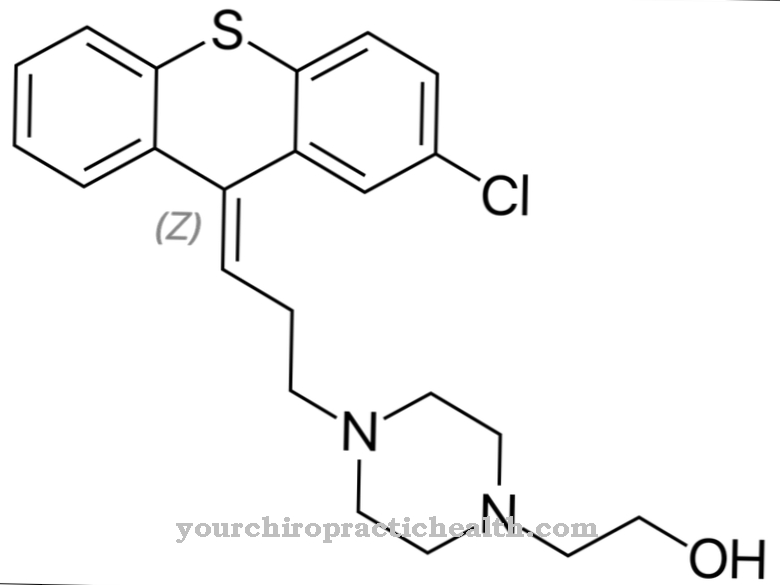The drug Ropinirole belongs to the dopamine agonists. It is used to treat Parkinson's disease and restless legs syndrome.
What is ropinirole?

Ropinirole is a medicinal substance that belongs to the group of dopamine receptor agonists. Its structure is similar to the important neurotransmitter dopamine. In contrast to numerous other dopamine agonists, however, it is not an ergot alkaloid.
In the early stages of Parkinson's disease, ropinirole is used as a single active ingredient. In the further course of the disease, it can be combined with levodopa (L-Dopa). When used as monotherapy, ropinirole does not achieve the same level of effectiveness as levodopa, but is considered more effective than bromocriptine. A partial replacement of levodopa administration is possible as part of a combination treatment.
Pharmacological effect
In the case of Parkinson's disease, there is a lack of dopamine in the brain. This substance is indispensable for the control of human movement. In healthy people, the production and breakdown of the neurotransmitter dopamine takes place permanently. However, if Parkinson's disease breaks out, dopamine production is continuously reduced, and the breakdown of the substance is not subject to any restrictions. After a short time, the lack of dopamine becomes noticeable through typical Parkinson's symptoms such as slowed movements, muscle tremors (tremor) and muscle stiffness (rigidity).
The dopamine itself cannot be administered in the form of tablets, because in this way the protective barrier that surrounds the human brain cannot be penetrated. To compensate for the dopamine deficiency, however, there is the option of taking different medications. These drugs also include the dopamine receptor agonist ropinirole. Although this substance has a different chemical structure than dopamine, it starts at the same binding points as the messenger substance, which results in comparable effects. In contrast to dopamine, ropinirole also has the ability to cross the blood-brain barrier to the brain. This allows the drug to compensate for the lack of dopamine, which in turn has a positive effect on Parkinson's symptoms.
Ropinirole, like the dopamine agonist pramipexole, has the ability to bind to D3 receptors. These are located on the brain cells. Due to the connection, the patient can implement his movements better and at the same time increase his mobility.
The half-life of 6 to 24 hours is significantly longer than that of levodopa, which is only 1.5 hours. This results in lower fluctuations in effectiveness.
Medical application & use
The main area of application for ropinirole is Parkinson's disease. The active ingredient is usually taken together with levodopa. Another area of application is the so-called restless legs syndrome. The affected people suffer from constant restlessness in their legs. The urge to move, which cannot be controlled, is particularly noticeable at night.
It is not uncommon for side effects such as shooting pain and muscle twitching to occur. Doctors also blame a lack of dopamine for restless legs syndrome. Ropinirole shows positive effects in the treatment of the disease.
In order to be able to stimulate the brain cells in the long term, it is necessary to take ropinirole for a longer period of time. Ropinirole is now administered as a prolonged-release tablet. This preparation releases the active ingredient continuously over a period of 24 hours. The tablet consists of three layers. These are the central layer in which the ropinirole is embedded, as well as two inactive boundary layers. Ropinirole tablets can be taken with or without food. It is important to always take the preparation at the same time as possible.
You can find your medication here
➔ Medicines to calm down and strengthen nervesRisks & side effects
Taking ropinirole can cause undesirable side effects. However, this does not always happen because each patient reacts individually to drugs. Most commonly, those affected experience insomnia, water retention in the legs, constipation, nausea, involuntary movements, drowsiness, dizziness, confusion, or hallucinations. Sometimes the movement disorders associated with Parkinson's disease may get worse, blood pressure may be low or you may fall asleep suddenly.
Some patients also show unusual side effects such as pathological gambling addiction or increased sexual desire. If a patient suffers from severe psychological disorders, therapy with ropinirole may only be given if the attending physician assesses the benefits of the treatment higher than the risks.
There are also some contraindications to treatment with ropinirole. These are hypersensitivity to the drug, the presence of a tumor in the adrenal gland (which produces hormones), and allergies to drugs such as neuroleptics. Caution is also advised in the case of severe cardiovascular diseases or psychoses.
In addition, interactions with other drugs must be observed. Ropinirole increases the effects of other dopamine agonists such as amantadine and selegelin. It is also not recommended to take drugs containing dopamine, adrenaline, noradrenaline, maprotiline, venlafaxine or desipramine without medical supervision. The same applies to circulatory preparations or drugs that lower blood pressure. Smoking also plays a role. Tobacco consumption has a negative effect on the potency of ropinirole.












.jpg)



.jpg)










.jpg)
